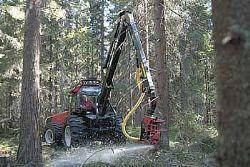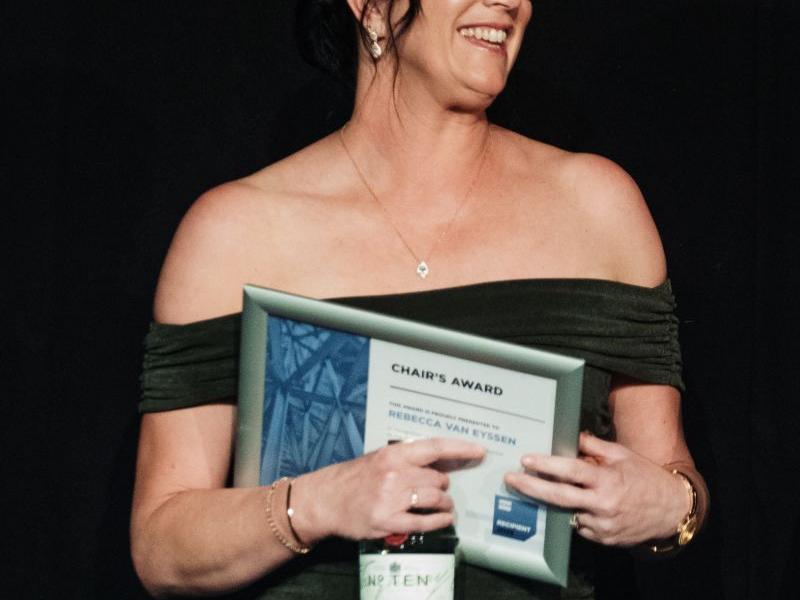The chief executive of Fibre-gen, Peter Carter, was recently named a finalist in the Manufacturing category of the annual Bayer Innovator Awards. Carter was recognised for his involvement in developing the Hitman wood quality assessment technology, used extensively in New Zealand’s forestry industry. The range of manual and automated Hitman tools use sonic technology to measure wood stiffness and related wood characteristics, and Fibre-gen owns the Hitman patents. Hitman tools can be used at all stages in the wood processing industry, from tree-breeding programmes, to mid-rotation and preharvest assessment in production forests, harvesting and delivery operations, log sort yards, and wood processing facilities. Carter says stiffness and fibre properties have long been recognised as key product variables in structural solid wood and pulp and paper processing. End product values are dependent upon the quality of raw material and method of processing. Log raw material is extremely variable in these properties and is dependent upon species, site, genetics, silviculture, and location in the tree from which logs are cut. “The need was recognised for a rapid, non-destructive test to be used on logs to determine their internal properties. Development focused on acoustic technology because it offered a direct measure of wood stiffness and related wood properties. “Hitman technology enables the extraction of greater value from forests by enabling the sorting of higher stiffness logs from those better suited to non-structural uses, by detecting differences in stiffness otherwise impossible to pick by eye or other simple measure. This improves wood processing efficiencies and enhances product grade recoveries,” says Carter. The Hitman range consists of four products: the HM200 and ST300, and their automated versions, the LG640 and PH330 – the latter in the final stages of development. The HM200, launched in 2002, is a hand-held tool for log segregation. It gives precise measurement of acoustic speed in logs up to 40 metres in length and has been proven across a wide range of species. How it works Carter explains how sonic technology works in the HM200. Plucking a guitar string sideways generates a series of transverse waves. The lowest frequency note is called the fundamental frequency or first harmonic (λ). The wavelength, 2L, is exactly twice the distance, L, between the two supports. Wavelengths of the higher notes are simple fractions of that for the fundamental, for example 2L/2, 2L/3, 2L/4 and the higher harmonic frequencies are exact integers of the fundamental – for example 2, 3, 4. However, the mathematics becomes very complex when an unevenly tapered, knotty stem flexes sideways. The HM200 therefore examines axial or longitudinal vibrations induced by hitting a crosscut end face of a log or board so that parts of the log are either stretching or compressing along the grain. The log ends are unrestrained so they show maximum (even if imperceptible) axial motion. As with the guitar string, the distance between the two ends is half the wavelength of the fundamental frequency. In a log the acoustic reverberation of the hammer impulse moves as a plane wave back and forth along the log, and by incrementally amplifying the signal as it decays it is possible to observe many passes – in some instances, many hundreds. The HM200’s accelerometer, pressed in contact with a log end, detects the repeated deceleration and acceleration as the compression wave hits the log end. Knowing the fundamental frequency (f) and the fact that its wavelength (λ) is two times the length of the log (L), it is easy to calculate the acoustic velocity from the equation V= fλ. Knowing that λ = 2L, it follows V = 2Lf. For the nth harmonic V = fnλn = (2L/(n+1))fn. An operator holds the HM200 against a stem or log and excites the stem or log with a hammer. The tool then measures the acoustic speed of the resulting sound wave. It can be applied anywhere in the production process, with the major benefit coming from application on the stem or log in the forest, skid site, or downstream in processing facility yards. Carter says customer feedback on using the HM200 to select logs with higher stiffness indicates it delivers increases of up to 20 percent in machine stress graded (MSR/MSG) timber meeting stiffness specification over that resulting from sawing unsegregated logs. Feedback also shows yields up to double the out-turn of high stiffness veneers for LVL compared to peeling unsegregated logs. In addition, it indicates enhanced ability to produce premium low coarseness or fibre cement pulps. The ST300, launched in 2004, assesses stiffness in standing trees. It consists of two probes that are hammered into the trunk about one metre apart, and a handheld PDA (personal digital assistant). The operator positions the probes with a hammer. The upper probe has an ultrasound distance-measuring device in it to determine the distance between the probes, as well as a laser to ensure accurate orientation. The operator taps the lower probe with a hammer. It sends an infrared signal to the upper probe to indicate the signal has left. When the sound wave arrives at the upper probe, it records it and derives the elapsed time. It calculates the velocity and sends the result by wireless Bluetooth to the handheld device, where it is recorded again. Says Carter: “Huge values are at stake when decisions are made to buy or sell stumpage or plan harvest, resulting in a long-recognised need for a quick and effective method of assessing standing trees. Similar high values are involved in advanced tree breeding programs. “Using the ST300 to define the stiffness and wood properties allows effective valuation and confident decision making. Stands of trees can be allocated to customers whose needs best suit the wood quality.” Meanwhile back at the mill The LG640 is an automated in-line tool that uses stress wave velocity to assess wood stiffness in logs during preliminary mill processing operations. Using this technology, logs can be sorted by lumber quality for particular uses and batched ready for optimal log cutting patterns or veneer peeling, thereby maximising recovered values. The system can be set up before or after the debarker for logs conveyed in either the longitudinal or transverse direction. It works without reducing the conveyor chain operating speed, with a maximum speed of 120 metres per minute. The LG640 consists of an automated hammer and a microphone. A photo eye and an encoder on the chain drive determine the log length. The hammer hits the log, and the microphone picks up the resonant frequency of the longitudinal sound wave in the log. The analysis works just like the HM200 hand tool, but with this automated device 100 percent of logs are measured so that each individual log can be custom cut or batch sorted to maximise the value of sawn timber or veneer produced. Waimea Sawmillers in Nelson installed an LG640 unit at its operations in September 2007. According to operations manager Kent Gibbons, this resulted in reduced costs and wastage, an increase in returns, and an additional three percent out-turn of structural quality timber. Gibbons says the introduction of the new timber grading standards NZS3604 and NZ3622 and market demands caused the operation to move away from visual grading. In 2006 it installed a sonic grader to automatically stress grade lumber output. However, the company also wanted to test logs for stiffness, to determine if they were structural grade or not, before sending them through for sawing. Gibbons positioned the LG640 on the debarker outfeed. This allows the operation to sonic grade every log into the green mill on a daily basis. Logs are queued on the infeed deck, and as each rolls into the machine infeed, its sonic reading displays on the operator’s control panel. Gibbons says this gives the operator the advantage of being able to adjust the cut pattern to maximize MSG output. “We’ve made at least a three percent gain in MSG recovery since installing the LG640, which equates to a significant improvement to the bottom line. And on top of that there are processing savings resulting from avoiding processing products to the wrong dimension of timber, as well as further savings from cost price reductions,” he says. Fibre-gen’s Peter Carter adds that the benefits paid for the device in just five months. Assessment prior to logmaking The other automated version of the Hitman, The Hitman PH330 for processor heads, is under development. It consists of a measuring tool incorporated onto a harvesting processor head to identify and optimise production of structural logs at time of harvest in the forest. The concept will see Hitman sonic assessment prior to logmaking. The processor head will drive the probes hydraulically through the bark into the sapwood. The system will measure the speed of sound between two probes in a similar manner as the ST300 hand tool. As the processor head progressively works along the felled stem it will assess the stiffness each time it stops to cut the previous log, providing a new sonic measure for the next to be cut. The wood quality measure will be integrated into processor head optimiser systems to maximise value recovery. This will effectively deliver structural wood into structural length logs and non-structural wood into alternative log grades. “Despite growing application of the technology to identify and sort structural logs after they are cut to length, it will always be best to know whether a stem is of structural quality before logmaking, so logs can be cut to the right length to meet customer specifications,” Carter explains. “Once logs are cut it is often too late to assess the quality, which may require them to be sent to a different customer – involving expensive rehandling, including transport costs, and loss of volume from recutting to a shorter length.” A PH330 unit incorporated into a Waratah 626 Bigwood processor was recently field tested with support from John Deere Waratah, Technology NZ, and Forest and Wood Products Australia (FWPA). Carter says the cost advantages of this technology can make a significant difference in an industry “where there is increased competition from a more aggressive global economy, shrinking margins and demand for high quality structural timber that meets new building code standards.” Wood processing companies in Australasia, North America, UK and Scandinavia are among the technology’s buyers. Jenny Baker is an Auckland-based freelance writer. For more information about the Hitman technology visit www.fibre-gen.com reader enquiries quote: D081019
Technology boosts timber processing efficiencies
General
Tuesday, 30 September 2008






